 |
|
| Saturday, May 11, 2002 |
|
Send in the Roborats Radio-controlled rodents could go places that St. Bernards can't. But that's not why they're important
Monday, May. 13, 2002 In one sense, the news last week that scientists have created a "roborat" represents an ingenious technical breakthrough. Engineers have tried for years--without success--to build robots smart enough to cross even a railroad track. Now, by combining off-the-shelf technology with a creature whose maneuvering skills have been honed by millions of years of evolution, physiologists at the State University of New York Downstate Medical Center in Brooklyn have created remotely piloted rodents that navigate complex terrain at the will of controllers who are more than 500 yards away. Wearing tiny backpacks equipped with radio transmitters and miniature TV cameras, the rats could someday be sent into a collapsed building to find survivors, say the scientists, or into a minefield to sniff out danger or off on a spy mission. But look a little deeper, and the accomplishment is both less and more than meets the eye. It's less in part because the technology involved is so simple. Trainers have known for centuries that you can teach animals to perform all sorts of behaviors with a system of rewards or punishments. Neurophysiologists have known for decades that instead of an external reward like food, you can send electric impulses directly into the brain's pleasure center. As they reported last week in Nature, Sanjiv Talwar and his colleagues did just that, tickling the rats' brains via radio transmitter when the rodents moved in a direction the researchers wanted. But although Talwar's team got the rats to do things they ordinarily wouldn't--climb trees, go out in bright light, ignore the scents of food and females--it took a controller at the helm to make this happen. So although the rats may sound like cyborgs, they are really just rodents that follow instructions. And although they fit into tiny spaces and are more or less expendable, they are less useful in many ways than bloodhounds or bomb-sniffing dogs--or even primitive robots, which will roll mindlessly into fires, under water or into the glow of a nuclear-power-plant meltdown. What's truly novel about this project is the way the rat controllers issue their instructions. By tapping a keyboard, they send signals via radio waves to electrodes implanted in the animal's brain: a mild jolt to neurons that sense the right whiskers means "turn right"; a zap to the left-whisker neurons means "go left." The surprise was how easy this was to do. Neurophysiologists have long dreamed of building artificial limbs with tactile feedback that would be sufficiently sensitive to tell a user when a hand is grasping a barbell tightly enough to keep it from falling or a baby chick loosely enough to keep from crushing it. That's what Talwar and his group were trying to understand. "We wanted to determine how well rats understand incoming signals," he explains. "When we stimulated a region of the whiskers, they 'felt' a touch." Someday, says Mandayam Srinivasan, director of the M.I.T. Touch Lab, who helped show two years ago that monkeys could control robots by thought alone, "you could build a neural chip for paralyzed people, similar to a cochlear implant for deaf people, that uses brain signals to control prostheses." That's far beyond what either he or Talwar can do today, and so they will keep working with lab animals--not to enslave them, as animal-rights activists may fear, but to understand how their brains issue and respond to signals. The idea of rescue or reconnaissance rats may continue to evolve as well. Ultimately, says Talwar, the animals themselves might become sensors. By implanting electrodes that record their neural activity, scientists could see what a rat sees, merely by reading its mind. Reported by Andrea Dorfman/New York
How to Wire Up a Rodent To steer a roborat by remote control, scientists rely on classic behavioral conditioning. First they implant electrodes in clumps of rat-brain cells that govern whisker sensation and pleasure. When human controllers want the rat to turn left, they beam a signal that triggers a mild electric shock to the left-whisker cells. If the rat responds by turning left, it's rewarded with stimulation of the pleasure cells. A right turn is signaled by a pulse to the right-whisker cells. No signal means the rat should go straight Source: Sanjiv Talwar, State University of New York Downstate Medical Center |
